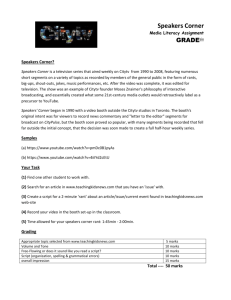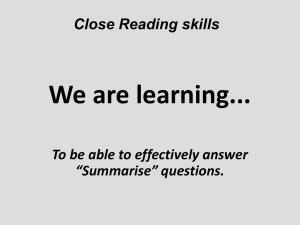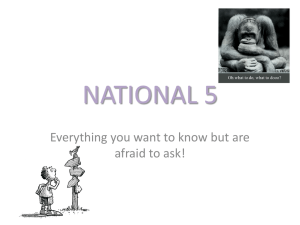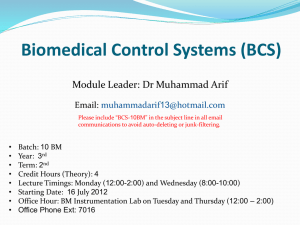Week 1 - Concept and Overview
advertisement
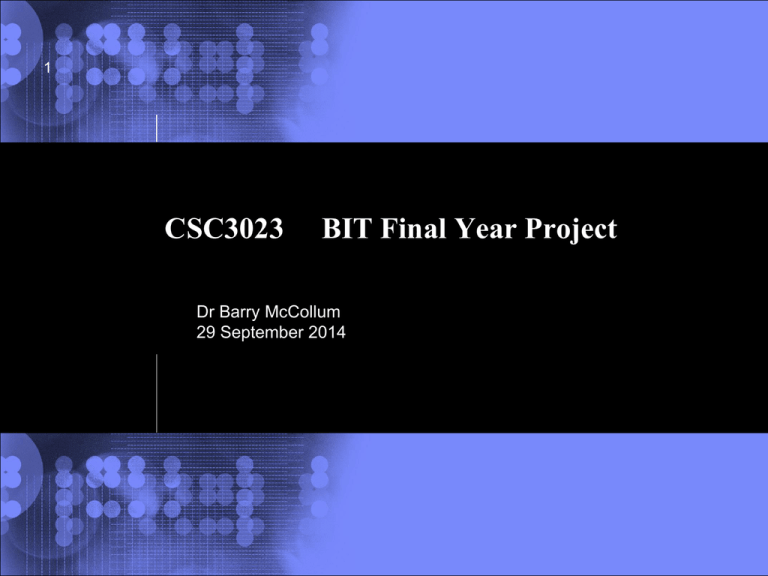
1 CSC3023 BIT Final Year Project Dr Barry McCollum 29 September 2014 © 2002 IBM Corporation Overview of Lecture Aims Learning Outcomes Outline Delivery Structure Assessment Your Responsibility 2 Aims work collectively to provide an IT solution to a business opportunity. develop the solution within a business framework Thus, allowing the central concept to be exploited commercially focuses on exploiting and developing the unique combination of skills taught to a group of highly motivated, capable and bright students. 3 Aims represents the bringing together of the areas of the BIT degree Industry feedback – inability of students to work in Groups encourage students to take the first steps in thinking about and establishing business ventures provide support and infrastructure for groups of students to bring their ideas to a state where they could become marketable optimise the use of electronic media to disseminate information, advice and best practice 4 Learning Outcomes allow students to use the combined skills learnt throughout the BIT Degree encourage students to think about the issues surrounding establishing a business allow students to reflect on differing approaches to problem solving enable students to experience/understand the complexities and benefits of working in teams allow students to assess their own performance as well as those around them in the overall success or failure of a project 5 Structure of Delivery Lectures Business Meetings (Tutorials) Begin Week 3 Guest Speakers Financial, Strategic Planning etc.. Group Presentations 6 Group Structure Managing Director - Business Growth Model - Background - Strategy - Models - Project Management - Branding Financial 7 Sales/Marketing Technical - Model - Design - Projections - Coding - Funding - Implementation Assessment 8 Element Percentage Type Interim Report 30% Group/Individual Group Presentation 5% Group System Demonstration 15% Group Dissertation 30% Group Development Diary 20% Individual Interim Report – Group Contribution (10%) Part A: Chosen Area Overview: Background and reasons (10 marks) Part B: Overview of proposed areas and solutions and reasons why not chosen (10 marks) Part C: Outline business plan: Structure and work completed (40 marks) Part D: Outline of the work to be completed (30 marks) Part E: Group Weekly Timesheet (10 marks) 9 Interim Report – Individual’s contribution (20%) Part A: Details of area proposed (15 marks) Part B: Gantt chart of how the individual’s work fits into the overall project’s milestone (10 marks) Part C: Detailing the Importance of the function adopted illustrating with at least three ‘real world’ case studies (35 marks) Part D: ‘lessons learned’ from the outside speakers. (40 marks) 10 Group Presentation Semester 2 10 minute presentation of Group’s ideas and their approach to the project Peer assessed purpose of this is to allow students to gain feedback from each other 11 System Demonstration Notes on Assessment issues 2 weeks before demonstration Demonstration artefact required Dissertation (May 2015) 12 Project Title / Abstract / Scope Section Headings: Detailed index of chapters, diagrams etc. Concise description of Business Case Business Model and key milestones Marketing Report Financial Projections e-commerce strategy Solution Specification and design Solution Implementation Contribution Matrix Conclusion and Reflection Development Diary 13 Work carried out and individual contribution Details of work carried out in various areas Notes on Outside speakers Individual Research reflect on the roles and responsibilities of the other group members Allows the peer assessment of the System Demonstration to be validated Chance to show their level of research and activity In addition marks will be awarded for critical analysis e.g. background research and talks given by ‘outside speakers’. Your Responsibilities Form into groups Self allocation in the first instance By end of week 2 ( Monday 13th October); Download, fill in and return “Formation of Groups” form Students not in a group will automatically be added to existing groups or placed in separate groupings Read in detail over material on Web Site 14 The Starting Point Groups of educated and motivated individuals Interest, knowledge and understanding of modern IT, business processes etc.. Frustrations and Ideas Capture all of this within a Business Context The next step is Idea Generation 15 Creativity – Turning ideas into a project (business) Initiate A point on which to nucleate ideas Imagine How could this be improved? Invent IT must be in the solution Implement Give thought to design and ‘rollout’ Sustain 16 Idea Generation Where are the Problems / Opportunities? What are you aware of? How do you find out? Potential Areas to Focus on e.g. Education, Health, Economy, Environment, Entertainment, Business Processes, Travel, Community, Retail, Family, Fashion and Beauty, Food, Gaming, Holmes and Housing, Security, recreation, Marketing and advertising, Non Profit Social Cause, Telecom and Mobile, Transportation, Style and Design 17 Idea Generation - examples Work experience areas of problems, high demand, customer complaints, frustrations and waste identified. Patterns and Trends e.g. Demographics Family size, exercise habits, perceptions, aging of population, work patterns Money available? 18 Idea Generation Talk to people Family / Friends / Relations / Neighbours Many ideas come from customers - so find people with a need or a problem. Magazines/Television Look to the USA for ideas emerging there. They tend to be several years ahead of us. Sell a complete package. Pull a range or products and services together to fully solve a specific problem. 19 Key issues Team ‘buy in’ Understanding of Team Strengths Initial background research Enthusiasm Attitude and belief Project Management Looking for opportunities which separate your team from others 20 21 Questions? © 2002 IBM Corporation






